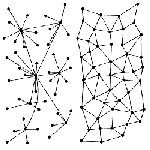Smart, wireless networked sensors will soon be all around us, collectively processing vast amounts of previously unrecorded data to help run factories, optimize farming, monitor the weather and even watch for earthquakes.
Many people (including me) think that wireless sensor networks can become as important as the Internet. Just as the Internet allows access to digital information anywhere, sensor networks will provide remote interaction with the physical world.
Today large, expensive and dumb
– tomorrow tiny, cheap and smart
Sensors are already everywhere. But most sensors used today are large, expensive and dumb – they lack the intelligence to analyze or act on their measurements, simply reporting for remote processing.
Soon, MEMS and nanotechnolgy will yield tiny, low cost, low power sensors. Tiny is important because they can be scattered around to measure just about everything that you can imagine. Low power because they won't need to carry a large battery and may even be solar-powered. Low-cost because the numbers required will be enormous.
Combination of three hot technologies
There are 3 basic technologies involved in sensor networks, a confluence of the hot technologies I have discussed in past Automationtechies.com columns:
- Micro miniature, ultra-low-power sensors (today these are usually MEMS; soon nanotech sensors will come on the scene).
- Embedded chips & firmware for P2P communications & self-organizing systems.
- Software for communications, control and optimization for thousands of nodes.
Together, these new developments are bringing intelligent, wireless sensors that talk with each other, forming intelligent networks spread over wide areas. Together, the sensors network process information into an overall analysis. Indeed, wireless sensor networks are one of the first real-world examples of "pervasive" computing – small, smart, cheap sensing and computing devices that will permeate the environment.
Sensor networks counter terror threats
Once tiny, low power sensors are available and the measurements are communicated and coordinated through peer-to-peer wireless links, the technology moves to whole new software arenas: pattern-recognition, heuristic analysis, self-organizing systems, and complexity science.
The funding required to develop this significant new technology synthesis quickly is becoming available. Against the backdrop of the war on terrorism, work is progressing on a nationwide sensor network that someday could provide a real-time early-warning system for a wide array of chemical, biological and nuclear threats across the US.
With a $1 billion budget in 2004, the US Department of Homeland Security is doing a significant amount of new development, plus coordinating the efforts of key scientists at national labs. The core technology relates to materials, sensors, networks and chips. Field trials of prototype networks are already starting.
MEMS and Nanotech will be used to create several low-cost, highly accurate biological and chemical sensors. On the networking front, peer-to-peer networks with multilevel security and quality-of-service guarantees will span wireless, wired and satellite links.
Within a few years, these technology developments will impact commercial markets, bringing huge new opportunities in other areas.
Ember's wireless sensor networks
An MIT spin-off, Boston-based EMBER is achieving significant advances in this field. MIT-Tech Review recently interviewed Ember CTO Robert Poor about his visions of a world filled with wireless networked devices. Interesting stuff – worth reading.
Ember sells radio chips with embedded processors that can organize themselves into networks to manage real-world data from sensors. The EmberNet self-organizing, self-healing mesh algorithms produce networks that are reliable, flexible, secure, and easy to use. Adding devices only makes EmberNet sensing and control networks stronger and more efficient.
As its markets expand, Ember envisions literally thousands of tiny sensors scattered profusely all over the environment for monitoring, surveillance, control, resource management, optimization, forecasting and prediction.
Applications
Immediate markets include Industrial Automation (process control), Defense (unattended sensors, real-time monitoring), Utilities (Automated Meter Reading), Building Automation (HVAC Controllers).
Within the next few years, distributed sensing and computing will be everywhere – homes, offices, factories, automobiles, shopping centers, super-markets, farms, forests, rivers and lakes. Even accurate weather prediction will be revolutionized through widespread wireless sensors.
In a flat or declining industrial automation marketplace, expect big growth from wireless sensor networks. Get your company involved. Or, join a company that is involved.
Related links:

 Smart, wireless networked sensors will soon be all around us, collectively processing vast amounts of previously unrecorded data to help run factories, optimize farming, monitor the weather and even watch for earthquakes.
Smart, wireless networked sensors will soon be all around us, collectively processing vast amounts of previously unrecorded data to help run factories, optimize farming, monitor the weather and even watch for earthquakes.

 Return to JimPinto.com HomePage
Return to JimPinto.com HomePage

